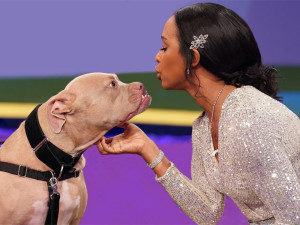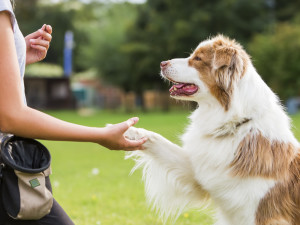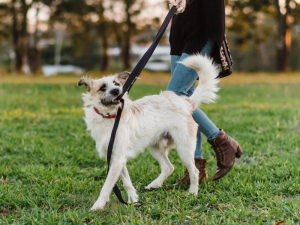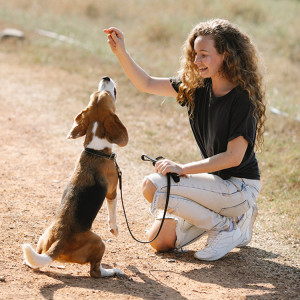How You Talk About Your Dog Matters
Why you should choose your words wisely.

Share Article
What you say matters, full stop. Listen in at the dog park, and you’re likely to hear all kinds of words used when people talk about their dogs. By tuning into what they’re saying, you can get a pretty good idea about the way they view their dogs, and what kind of relationship they have with them. Your words show how you view the world, what has value for you and what doesn’t. Because words are powerful, you must take care when wielding them — including when it comes to discussing dogs. Here are some terms to listen for, and what they may be saying about the speaker’s unconscious perspective toward dogs.
“Cue,” not “command.”
In old-style dog training, people issued commands and expected their dogs to obey. When a dog didn’t comply with a command, they were considered disobedient and was perhaps punished. The modern approach is to give the dog a cue to let them know what you want them to do. When a dog doesn’t respond appropriately to a command, it’s easier to acknowledge that they might have misunderstood it, or been distracted.
What’s the difference? Cues offer dogs opportunities to perform behaviors for the possibility of reinforcement, while a command offers the possibility of being punished if their response is not what was desired. The change from saying “command” to saying “cue” doesn’t produce this change in perspective — it simply reflects it.
“Confused,” not “bad.”
When dogs don’t do what we want or have asked them to do, it isn’t unheard of to hear them described as misbehaving or bad. Using derogatory terms to describe a dog who is unsure about what we want puts all the blame on the dog and none on the people.

It’s far better to consider them “confused” or “uncertain” — they weren’t able to be successful at that moment out of confusion, uncertainty, or insufficient training rather than to slap on a negative label after an undesirable response.
What’s the difference? Suggesting that there was a barrier to success (such as a distracting smell or a lack of training in a particular context) as opposed to calling the dog bad, stubborn, or resistant shifts the viewpoint from the dog giving you a hard time to the dog having a hard time. It’s also a good way to reframe your interaction with your dog and to increase your empathy with them.
“She,” “he,” or “they,” not “it.”
Many times, animals are referred to by the pronoun “it,” the same word we use for inanimate objects like chairs and washing machines, which is pretty impersonal. Using a pronoun such as “he,” “she,” or “they” makes it more personal, acknowledging that the dog is an individual, living being.
What’s the difference? Using these pronouns better reflects the close relationship and the emotional connection you have with your dog. Today, almost everyone uses a gendered pronoun, rather than the impersonal “it.” As “they” becomes a more common pronoun for both individuals and for groups, it also carries a more personal connotation even though “they” is used for both living beings and inanimate objects.
“Mix,” not “mongrel.”
There are a lot of terms for dogs who do not belong to a specific breed. Some people consider the term “cross” appropriate for a dog who has two purebred parents of different breeds and use “mix” or “mixed breed” for dogs whose ancestry includes more than two breeds. Both of these terms are descriptive, and many consider them neither positive nor negative but simply factual. However, “mongrel” and ��“cur,” which reference dogs of unknown or highly diverse ancestry, are considered to be derogatory.
What’s the difference? Using terms for dogs of complex or unknown ancestry that imply anything bad about such dogs is problematic because it suggests some dogs are inherently inferior or less valuable than other dogs. Interestingly, “mutt” used to be considered a rude way to refer to a dog who was not purebred, but the term has been elevated to one of affection and respect. In fact, many use the term with the most positive of connotations. Again, language matters.
“Well-trained,” not “compliant/obedient.”
When people talk about a dog who is compliant or obedient, there’s an implication that the dog is responding to force or power, neither of which is helpful in a loving relationship. On the other hand, if a dog’s behavior is admirable and the explanation is that the dog is well-trained, that conveys a much more positive feeling.
What’s the difference? Saying that a dog is well-trained suggests that the dog has learned a lot, and that someone has taken the time and effort to teach the dog how to behave. It is so much more pleasing to think (and say) that the dog knows what to do and does it rather than to assert that the dog is being coerced to act a certain way.
“Parents, not owners.”
People who still refer to themselves as their dog’s owner are viewing the relationship quite differently than people who call themselves their dog’s guardian, pet parent, or best friend.
What’s the difference? The idea that dogs work for us is not the same as the notion that they are members of our family, just as children are. There is a big difference between being a parent of your dog and being your dog’s owner. How you describe the relationship between yourself and your dogs is an indication of how you think of that relationship.
Language matters when you’re talking about your dog. So, choose words thoughtfully and enjoy the benefits of more loving, more caring relationships with your BFF.

Karen B. London, PhD, CAAB, CPDT-KA
Karen B. London is a certified applied animal behaviorist (CAAB) and certified professional dog trainer (CPDT) who specializes in working with dogs with serious behavioral issues, including aggression. She has written for a variety of magazines including The Bark, Clean Run, and the APDT Chronicle of the Dog, and has published in scientific journals including Behavioral Ecology and Sociobiology, Ethology, Ecology, and Evolution, the Journal of Insect Behavior, and Insectes Sociaux. She is the author of seven books about dog training and canine behavior, including the forthcoming My Dog's Mystery Adventure: And Other Stories From a Canine Behaviorist and Dog Trainer.
Related articles
![A red haired woman dog trainer kneeling in front of a Shepherd mixed breed dog with one finger raised that the dog is looking at in an outdoor training course.]()
Understanding Popular Dog Training Methods
Look behind the advertising language when picking a dog trainer.
![A man with long brown hair playing tug -of-war with his Golden Retriever dog outside on a wet tennis court]()
Play-Training Can Be Your Solution to Dog Aggression
Behavior correction, Mary Poppins style: Turn a job into a game.
![A woman holding up a treat while shaking a dogs paw.]()
So, You Want to Work with Animals
On the prowl for a new career path? A director at the Humane Society has some pro tips.
![Scruffy dog tugging on leash as owner is pulling it]()
How to Change the Way You Think About Your Dog’s Behavior
Instead of focusing on the negatives, here’s what you should do instead.
![Female dog trainer raising a treat above a beagle dog's head]()
Your Dog’s Trauma Triggers Are Everywhere. Fear-Free Training Can Help
“America’s Veterinarian” and the founder of Fear Free Pets, Dr. Marty Becker, on how this method makes vet visits, training sessions, and grooming appointments less stressful for pets.
![A woman in a black coat squatting down to speak to her Dalmatian dog who is looking away from her to the camera on a dirt path next to a pond on with fall leaves around]()
Hey, Why Is Your Dog Ignoring You?
Six tips and tricks to get your dog to listen to you.







